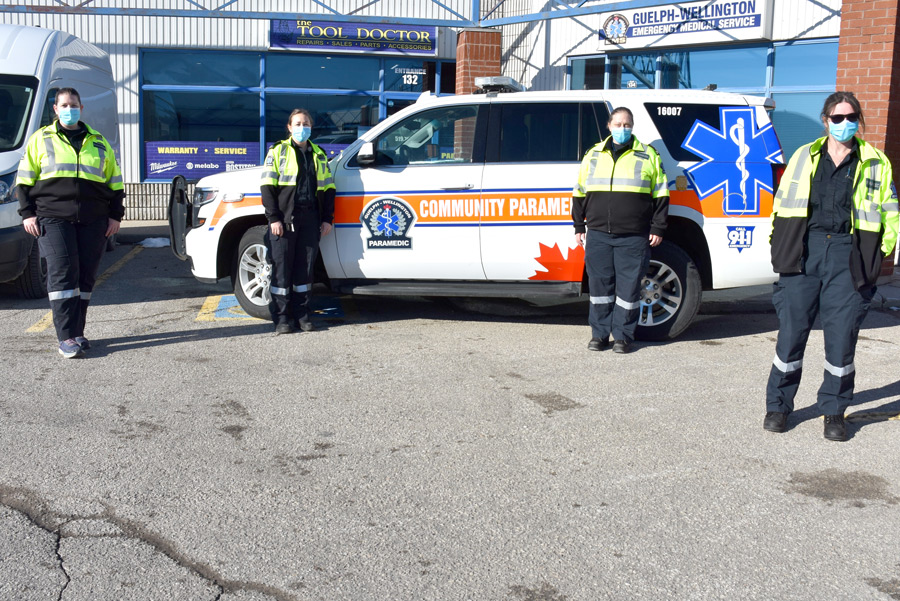WELLINGTON COUNTY – Guelph-Wellington paramedics are addressing the needs of seniors living at home who are stuck in a backlog, some for years, awaiting a long-term care bed in Wellington County.
Over the next four years, Guelph-Wellington Paramedic Service is spending $6.1 million received from the Ministry of Long-Term Care (MLTC) on its Community Paramedicine for Long-Term Care (CPLTC) program.
Focusing on residents who are either waiting for a placement into a long-term care home, are soon to be eligible for a waitlist, or who are anticipated to join a waitlist in the near future, paramedics are providing in-home medical assessments and helping clients to navigate the healthcare system.
“This initiative will help more seniors on long-term care waitlists stay safe while living in the comfort of their own homes for a longer period of time,” said MLTC media staffer Rob McMahon in an email, adding that community paramedicine programs provide “peace of mind” to seniors and family members.
A previous iteration of the concept, known as the “High Intensity Supports at Home” (HISH) program, ran in the county from October to December last year, focusing on those outside of hospital settings who required alternate levels of care.
“We’re continuing the work that we started with that HISH program up in Harriston and we’re expanding it to provide additional staff and additional services through Wellington County and also now into the city of Guelph,” said GWPS deputy chief Leanne Swantko.
There are 1,410 individuals waiting for a bed in a long-term care home within Wellington County as of May 12, according to an email from Home and Community Care Support Services spokesperson Rebecca Boucher.
While new admissions into long-term care homes have continued throughout the pandemic (provided the receiving facility isn’t in a COVID-19 outbreak) homes have been advised there can be no new admissions into ward rooms which already have two residents.
Donna Duncan, CEO of the Ontario Long Term Care Association (OLTCA), an advocacy group for the sector, said the population of those over 80 is expected to double in 16 years, and with many waitlisted seniors living with dementia, a person’s needs can become too great to remain at home.
Duncan underscored an “urgent need” to add “thousands” of new long-term beds to help provide care for a growing number of seniors with advancing conditions.
Across the province there are approximately 40,000 people waitlisted for a long-term care bed as of Dec. 31, 2020, according to McMahon of the MLTC.
“That’s where there’s a need; we’ve seen that need, we see folks using 911 services, maybe not appropriately, or we see clients who have stayed at home and their medical condition has deteriorated to the point where not only do they need to have a hospital visit, but even admission into the hospital,” Swantko said.
A March 2021 report from the Waterloo Wellington LHIN shows wait times for a basic bed ranging anywhere from 54 days on the low end at Caressant Care Fergus (with an average of just one bed freeing up per month) to over five years on the high end at St. Joseph’s Health Centre in Guelph, where an average of seven beds become available each month.
“It has just been insane with the amount of work we’ve been getting through these programs,” Swantko said, noting community paramedics also focus on remote monitoring of vitals for people with chronic health conditions, proactive visits of frequent 911 callers, and are having an increasing role in at-home COVID-19 vaccinations — to name some.
The service’s client list is fluid, changing as demands evolve, but according to Swantko, there were at least 150 clients connected to the CPLTC program as of May 12.
“Community paramedicine was completely built on 911 call mitigation, but what we found is paramedics had a great skill set that played really well in this program … it’s providing [clients] additional supports while they’re on that waitlist to make sure they can stay home safely, that they’re independent and comfortable,” Swantko explained.
The service works collaboratively with family health teams, the Canadian Mental Health Association, and Home and Community Care Support Services to be connected with clients.
Paramedics responding to medical emergency 911 calls can also make internal referrals to the CPLTC program.
“Sometimes a paramedic will come across a patient that’s not connected to resources that really need resources and this program can allow us to not only take them in and provide them services, but then connect back to other agencies,” Swantko said.
Community paramedics in the county are presently operating out of the Minto fire department’s Harriston station, but plan to relocate to a renovated former county public works building in Drayton by autumn, where paramedics will staff two newly procured SUVs around the clock.




